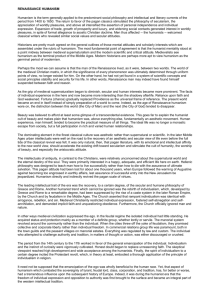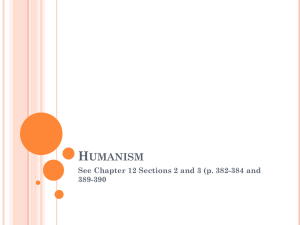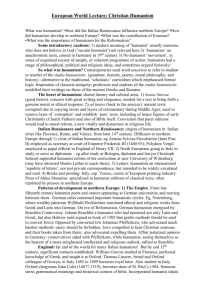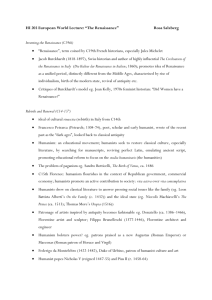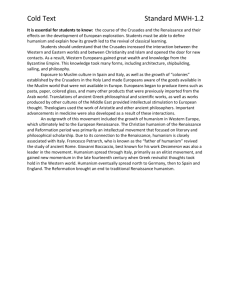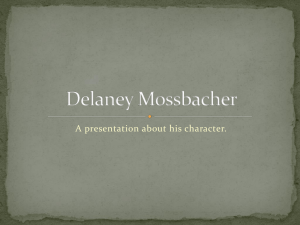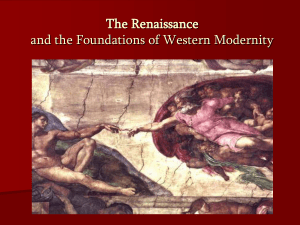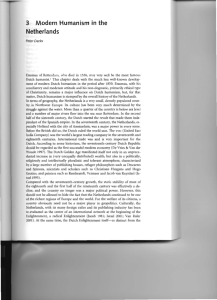Lemma Netherlands EDITED2 def versie
advertisement
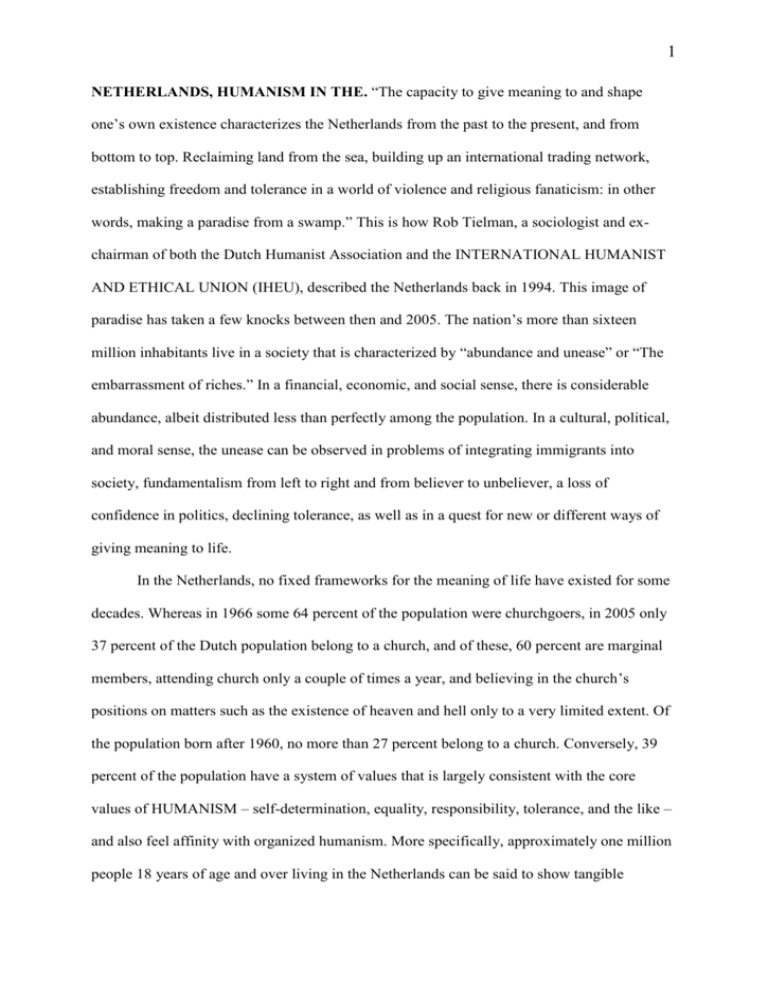
1 NETHERLANDS, HUMANISM IN THE. “The capacity to give meaning to and shape one’s own existence characterizes the Netherlands from the past to the present, and from bottom to top. Reclaiming land from the sea, building up an international trading network, establishing freedom and tolerance in a world of violence and religious fanaticism: in other words, making a paradise from a swamp.” This is how Rob Tielman, a sociologist and exchairman of both the Dutch Humanist Association and the INTERNATIONAL HUMANIST AND ETHICAL UNION (IHEU), described the Netherlands back in 1994. This image of paradise has taken a few knocks between then and 2005. The nation’s more than sixteen million inhabitants live in a society that is characterized by “abundance and unease” or “The embarrassment of riches.” In a financial, economic, and social sense, there is considerable abundance, albeit distributed less than perfectly among the population. In a cultural, political, and moral sense, the unease can be observed in problems of integrating immigrants into society, fundamentalism from left to right and from believer to unbeliever, a loss of confidence in politics, declining tolerance, as well as in a quest for new or different ways of giving meaning to life. In the Netherlands, no fixed frameworks for the meaning of life have existed for some decades. Whereas in 1966 some 64 percent of the population were churchgoers, in 2005 only 37 percent of the Dutch population belong to a church, and of these, 60 percent are marginal members, attending church only a couple of times a year, and believing in the church’s positions on matters such as the existence of heaven and hell only to a very limited extent. Of the population born after 1960, no more than 27 percent belong to a church. Conversely, 39 percent of the population have a system of values that is largely consistent with the core values of HUMANISM – self-determination, equality, responsibility, tolerance, and the like – and also feel affinity with organized humanism. More specifically, approximately one million people 18 years of age and over living in the Netherlands can be said to show tangible 2 evidence of active affinity with the humanist movement. This makes humanism the third largest LIFE STANCE movement in the Netherlands, after Protestantism and Catholicism. However, the official number of organized humanists (registered members of one of the two large humanists organizations) is far lower, and is even declining: approximately 28,000 members. Nevertheless, organized humanism offers a broad and comprehensive package of services, which, although largely paid for by the government, is completely independent of government in terms of content. Understanding this paradoxical situation requires some knowledge of the history of the Netherlands. Religion and Secularization. The Dutch have a long tradition of religious tolerance and pluralism, and especially of religious freedom, from the Napoleonic period in the early nineteenth century. The preceding two centuries were dominated by the Dutch Reformed Church, although other religious traditions were tolerated. More to the point, the Dutch have a strong humanist tradition drawn from ERASMUS, Dirck Volckertszoon Coornhert, and SPINOZA; the first Dutch constitution of 1798 incorporated several essential principles for building a secular democratic constitutional state. The most important of these were: “Every citizen has the freedom to serve his god in accordance with the conviction of his heart,” and a radical separation of church and state. The Calvinists, who separated from the Reformed Church in the nineteenth century, and the Catholics felt that they were being treated as second-class citizens in the second half of the nineteenth century, and started to organize themselves separately. They can be viewed as social movements based on religion. Their aim for emancipation was based on the principle of equal rights. These emancipation processes resulted in a typically Dutch solution: “the ideological separation of society,” which is also referred to as the “pillarized society.” Society was divided into different religious “pillars,” a metaphor for pillars standing side by side, without contact except by way of the roof that they 3 are supporting. Each pillar had its own institutions including political parties, trade unions, newspapers, hospitals, broadcasting stations, and social work institutions. The social life of citizens was often restricted to their own community. At the end of the nineteenth century there were two large communities, or pillars, based on worldview: the Catholics and the Protestants. A third pillar consisted of non-religious groups, such as liberals, socialists and free thinkers (see FREETHOUGHT), or humanists; this was called the neutral pillar. This social constellation was possible because of two simultaneously-acting principles: on the one hand, pacification and non-intervention in one another’s spheres of influence; and on the other hand, the principle of equal entitlements, which meant that the different communities would receive identical rights and services. One reason this could work is that the pillars were numerically roughly equal. Until approximately 1960, the pillarized system worked well, but then disintegrated rapidly as a consequence of the all-embracing modernization process in society, which was characterized by rationalization, individualization, and SECULARIZATION. The traditional communities fell apart and lost influence. The pillars and the related institutions were dismantled at a rapid pace by this process, with the exception of parts of the health care, education, and broadcasting sectors. An essential point for the current position of organized humanism is that between 1945 and about 1989, it had been able to benefit from the equal entitlement principle mentioned above by setting up a variety of organizations for practical activities, from social work and education to broadcasting, which were largely paid for by the government. This happened despite the fact that humanists were and are opposed in principle to dividing society into pillarized blocks. Organized Humanism. The founding in 1856 of the free-thinkers association De Dageraad, currently De Vrije Gedachte (see NETHERLANDS, UNBELIEF IN THE), marked the 4 beginning of the modern organized humanist movement in the Netherlands. Shortly after the end of World War II in May 1945, two humanist organizations were founded independently of each other: in May 1945 Humanitas, and in February 1946 the Humanistisch Verbond (HV). Humanitas is an organization for social services on a humanist basis. Its founders, predominantly social democrats, wanted to provide churchless people with an alternative for the social assistance traditionally provided by the churches. They mainly offered practical help to people in need. For them, humanism was translated as seeing the person as an individual, but at the same time as a part of society. The focus was on both personal responsibility and care for other people, which was substantially different from church-based charity. Humanitas expanded considerably in a short time and organized itself into local departments. A characteristic feature of Humanitas was, and still is, that a substantial part of the work is carried out by self-trained volunteers. Over the years, the work evolved from providing individual social services more towards community development. The number of members declined between 1980 and 1994, while many subsidies have stopped, and Humanitas is in search of new ways forward. These ways are being found in the promotion of community development, especially that based on “empowerment”: supporting people in marginal positions to acquire a substantive place in society through their own efforts and with their own, possibly limited, resources. In 2005 the work was carried out by approximately 10,000 volunteers in five districts and eighty local departments. Humanitas has approximately 15,000 paying members, and the volunteers are supported by approximately 200 paid executive staff. In addition, Humanitas itself is spawning several large independent humanist organizations in the fields of child day care and care for the elderly, with over 3000 workers and 800 volunteers. The Humanitas motto is: “Do what you have to do”, which is a good example of an extremely practical form of humanism. 5 The Humanistisch Verbond (HV, Dutch Humanist Association), founded on February 17, 1946, gave both substantial and organizational direction to organized humanism in the Netherlands between 1946 and 2000. The two most important motives for founding the Verbond were described by Jaap van PRAAG, the undisputed “father of modern Dutch humanism,” as “the major and the minor struggle.” The “major struggle” was concerned with supporting and providing a LIFE STANCE “roof” for the large group of people that the church had abandoned and who had a mainly implicit humanist worldview, if any: they were at risk of sliding into futility and nihilism (moral indifference), partly in response to memories of the horrors of World War II. The minor struggle was for the emancipation of churchless people seeking a fully-fledged position in society. The minor struggle in particular was conducted with verve, and made grateful use of the same weapons that its opponents, especially the Catholics and Protestants, had developed in their own emancipation struggles. These weapons included pacification and non-intervention in one another’s spheres of influence and the principle of equal rights for separate ideological groups. Despite the Verbond’s small membership, because of considerable hard work, effective lobbying on the part of a strategically formed board, and by keeping in step with Dutch civil society without causing offense, the Verbond’s struggle had delivered many successes by around 1970. Conspicuous were equal state-funded entitlements in humanist counseling, broadcasting, development aid, and education. A milestone was reached in 1965 with a government declaration that explicitly recognized both the Judaeo-Christian tradition and humanism as the basis of society. The secularization of society also had a direct influence on the course of the Verbond. From 1966, the HV had considerable difficulty in finding a new mission and a new humanist program that could command enthusiasm in what was becoming an increasingly humanist society. Under the chairmanship of Rob Tielman (1977-1987), the HV had a clear identity as 6 an organization that favored a worldview based on the principle of self-determination of individuals, worked for legalizing abortion and euthanasia, opposed discrimination against homosexuals, and promoted the emancipation of women. After this period came a long episode in which the HV searched for form and content. This coincided with the loss of subsidies and a considerable fall in the number of members. In 2005, the HV is concentrating on the association itself (43 departments); providing services, such as speeches at funerals, humanist counseling, and relationship celebrations; and propagating a humanism centered on individual freedom of choice and responsibility. The motto of the Humanistisch Verbond is “think independently, live in fellowship.” It is possible to defend the assertion that what van Praag called the “major struggle” – against nihilism and for the moral resilience of the public – never really took off, but is actually where a great need exists in the current time of abundance and unease. The HV is now trying to satisfy this need in the Humanistische Alliantie (Humanist Alliance), which was founded in 2001 and is reviewed below. For the HV, humanist counseling (a sort of secular chaplaincy) was an important practical form of humanism. It became established after 1950 in the army, prisons, and the healthcare sector. In the 1970s army, prison, and hospital counseling were spun off into separate organizations still under the supervision of the HV. Since 1989 counselors have been trained at the University for Humanistics in Utrecht, which is fully state-financed as an accredited university, like the Roman Catholic and Protestant theological universities (see NETHERLANDS, HUMANIST EDUCATION IN THE). As of 2005 some 250 humanist counselors work on a professional basis. Other organizations. Hivos (Humanist Institute for Development aid), founded by the HV and De Vrije Gedachte in 1968, is a humanist development organization that stands for 7 emancipation, democratization, and poverty reduction in developing countries. The reason for founding Hivos was the complete absence of a state supported development organization that worked from a non-Christian ideology and explicitly used non-Christian channels to deliver aid. As an official non-governmental organization, Hivos spends more than seventy million euros yearly in support of local organizations and initiatives in developing countries: currently in more than thirty countries in Africa, Asia, and Latin America. Among the priority areas are human rights and aids, the environment and development, gender, and women. The IHEU is an important link for Hivos in supporting humanist-oriented organizations in developing countries. From around 1946, the sound of humanism has been heard on national radio and later on national television. In 2005 the Humanistische Omroep (Humanist Radio and TV) is an independent foundation under the Verbond, with approximately 20 paid staff providing 208 hours of radio and 39 hours of television a year. Characteristically programming focuses on topics such as world citizenship, culture, autonomy, and soical engagement. In addition, the humanist movement has two explicitly humanist periodicals that are independent of the direct influence of any organization. The Humanist is a bimonthly magazine aimed at a general public, with articles on the broad areas of giving of meaning to life and worldview. The Journal for Humanistics can be considered an academic journal. Published four times a year, it focuses on the interface between social developments, cultural issues and existential themes. A fairly recent branch of the humanist organizations’ family tree is the Humanist Archives, founded in 1996 as a center for the archiving and documentation of history with respect to humanism in the Netherlands from 1850 to the present. In addition to managing archives such as the IHEU archive, the Humanist Archives collect publications and maintain a heavily-used website. 8 All the explicitly humanist organizations, mentioned above or otherwise, form a complex weave of theoretical and practical orientations that cover a large number of social fields including healthcare, education, mass media, human rights, development aid, social work, and dealing with the existential concerns of individuals. The roots of this family tree are formed by De Vrije Gedachte, Humanitas and the Humanistisch Verbond. Renewal of Organized Humanism. A renewal effort for organized humanism was urgently called for. Because the core values of humanism had been widely accepted and a high level of individual emancipation had been achieved in Dutch society, organized humanism needed to redefine its mission. In addition, there had been a sharp decline in the number of organized humanists and an almost total disappearance of state subsidies. This renewal effort is currently proceeding along two lines. The Humanistische Alliantie (Humanist Alliance, a federation of humanist organizations) founded in 2001, aims to act as a “network organization” to strengthen humanism and the humanist movement, among other things by jointly developing humanistinspired visions and practices, promoting common interests in the world of politics and society, conducting joint communication activities, and coordinating fundraising activities. Above all, they aim to give humanism in the Netherlands a voice in societal debates. All large humanist organizations and others belong to the Alliantie, comprising (as of 2004) 17 member-organizations and about 25 partner organizations, encompassing some 12,870 volunteers, 57,550 members/donors and 6,410 paid staff. The second line of innovation is related to the content of humanism as a worldview. “The” humanism is no longer a clearly defined entity in the Netherlands, having splintered in recent decades into substantially different “humanisms.” Besides the traditional humanism as a life stance and worldview, oriented to giving meaning to life, there is “political” humanism, 9 which sets out to achieve the humanization of society from moral and political motives and is rapidly gaining ground. Nor have atheistic humanism or the RELIGIOUS HUMANISM disappeared. At the same time, humanism has spread far and wide in society. Although the number belonging to humanist organizations has declined, humanism as a social principle is clearly on the rise. Though a relatively small percentage of the population that counts itself part of the humanist movement, a far larger percentage feels affinity with humanist ideals, while the values shared by an even larger fraction of the population reflects such humanist core values as self-determination, equality, responsibility, tolerance, and the like. Bibliography Boelaars, Bert. De kostbare mens. Inleiding tot het humanisme. Amsterdam, De Arbeiderspers, 1997. Derkx, Peter. Modern Humanism in the Netherlands, in: Halsema, A., and D. van Houten, eds., Empowering Humanity: State of the Art in Humanistics. Utrecht, De Tijdstroom, 2002. Gasenbeek, Bert. “An Analytical Framework for Describing and Analysing Humanist Organizations,” in Humanism and Laicity in Europe. Berchem, European Humanist Federation, 2002. Lammerts, Rob and Susan Hopstaken. Humanisme in beeld: een onderzoek naar de daadwerkelijke affiniteit met het humanisme. Utrecht, Verwey-Jonker Instituut, 2004. Tielman, Rob. “Is Nederland van God los?” in Civis Mundi 33 ( 1994) 4 (November). 10 Van Houten, Douwe. “Humanist Counseling in the Netherlands,” in Halsema and van Houten, eds., Empowering Humanity. Van Praag, J.P. Foundations of Humanism. Buffalo, New York: Prometheus Books, 1982. Bert Gasenbeek,
